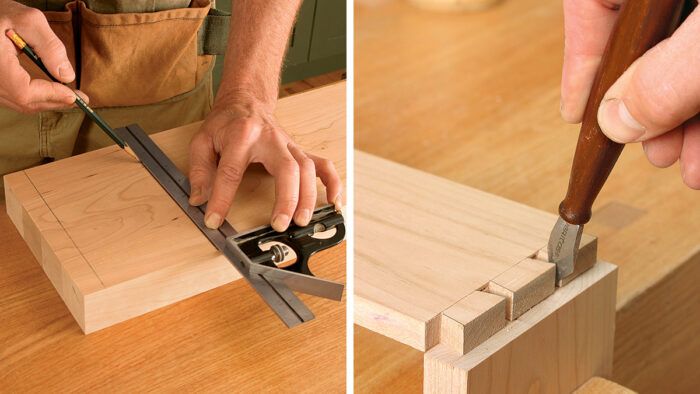11 Essential Measuring and Marking Tools
Accurate layouts become routine when the right tools are close at hand.

Synopsis: Careful layout is crucial to a woodworking project. Measure or mark a part inaccurately and it almost certainly will cause problems. With that in mind, Chris Gochnour gives the lowdown on his 11 favorite measuring and marking tools. These are the tools he keeps within easy reach and uses almost every day: 12-in. combination square, framing square, 4-in. engineer’s square, 12-foot tape measure, 6-in. straight rule, marking knife, pencils, dial caliper, marking gauge, bevel gauge, and scratch awl. As important as any hand or powered cutting tool, these tools are essential for a well-equipped workshop.
Careful layout is important to every woodworking project. Measure or mark a part inaccurately and it almost certainly will cause problems along the way.
That point was driven home recently as I taught a woodworking class where students used mostly hand tools to build a Hepplewhite writing desk. As the class progressed, the correlation between effective layout and successful woodworking was clear. Students who carefully laid out their projects with crisp, concise markings built their desks quickly and efficiently, with fewer setbacks. Students who laid out their projects with faint and irregular markings had to work at a slower, less productive pace. Not surprisingly, the latter group took longer to complete their desks, and the quality level was not up to that of the other students.
All that led me to consider my favorite measuring and marking tools, the ones I keep within easy reach and use nearly every day. These 11 tools are as important to my work as any hand or powered cutting tool. A well-equipped workshop, I feel, should include one of each.
Framing square
Another square I find useful, particularly for large-scale work, is the framing square. Although generally viewed as a carpenter’s tool, it is extremely useful in the woodshop. Made from one piece of aluminum or steel, roughly 1⁄8 in. thick, with one arm incrementally marked to 16 in. and the other to 24 in., it serves as a jumbo try square for larger work.
Among other tasks, I use mine to lay out cut lines on panels or wide lumber, to define joinery across wide case pieces, to test the corners of panels to verify accuracy, and to check case assemblies for squareness during glue-ups.
Although framing squares are not expensive and generally are not viewed as precision tools, I’ve used the same one for 20 years and have never had to true it up. I treat it with care, and like an old friend, it has never let me down.
From Fine Woodworking #182
For the full article, download the PDF below:
Fine Woodworking Recommended Products

Suizan Japanese Pull Saw

Festool DF 500 Q-Set Domino Joiner








Log in or create an account to post a comment.
Sign up Log in